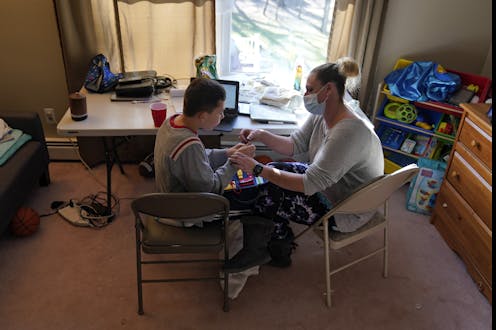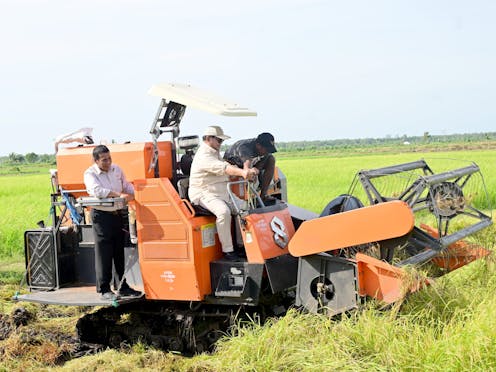Students with disabilities are not getting help to address lost opportunities
- Written by John McKenna, Associate Professor of Special Education, UMass Lowell

Even before the pandemic hit, 98% of U.S. school districts[1] said they didn’t have enough special education teachers to serve all the students who needed their help. During the pandemic, short-handed school districts were even more stretched to provide learning support to students with disabilities. Now, those students are struggling to catch up with where they should be.
In fall 2018, according to the most recent federal data available, there were 6.1 full-time special educators for every 100 students[2] who received special-education services, varying widely by state, from 2.8 in Oklahoma to 12.1 in Washington, D.C. Special education teachers have long described their work as very demanding with little support[3], high stress[4] and low pay.
Then the COVID-19 pandemic forced schools to rapidly shift from traditional in-person teaching to virtual classes[5] on laptops and smartphones in students’ homes. The sorts of services common in special education – additional support within a child’s classroom, and dedicated time with specialists outside the classroom – became difficult, or even impossible[6], to provide.
In an early 2020 survey of parents of children enrolled in special education services, just 20%[7] reported that their child received all the support the school was required to provide. Another 39% reported that their child actually received no services at all. A federal report in June 2021 documented schools continuing to have difficulty[8] serving students with disabilities.
As a lifelong special educator who now studies the field[9], I have seen that many students who needed support before will need even more to get back on track. I worry that, as the pandemic ends, many students who did not previously have mental health difficulties, or whose conditions did not significantly affect their readiness to learn, may now have difficulties or disabilities that require assistance from a system that is already strained.
Business as usual
There are still shortages of special education teachers[10] across the country. There are also reports that children are not receiving required services[11] even after they’re back in school buildings. Services may include speech and language therapy, math and reading support, and instruction to improve social and emotional skills. Services vary from student to student, based on their individual needs.
Under a civil rights law, students who did not get proper services during the pandemic may be eligible for additional support[12] – beyond their existing special education plan – to catch up with where they should be. When determining what a student may be entitled to, schools and families consider the benefits that were lost because the student did not get what they were entitled to. Services to address this problem will also vary from student to student.
But there are problems with that additional help as well, as schools continue to do their best with the resources that are available to them. A November 2021 survey by the Council of Parent Attorneys and Advocates – an advocacy group for students in special education and their families – found that 86% of parents[13] reported that their child experienced learning loss, skill regression or slower-than-expected progress in school.
But just 18% of parents said their child received additional support to recover ground lost during the pandemic. And 14% of parents believed that school districts’ decisions about who got that additional help were unfair.
A new group of students in need
The pandemic worsened what was already a crisis[15] in young people’s mental health in the U.S.
A January 2021 survey from the JED Foundation, a nonprofit working to improve children’s and teens’ mental health, found that nearly two-thirds of U.S. parents[16] reported their child experienced a mental or emotional challenge in the previous month. That included more common complaints like social anxiety and isolation, and less common but more severe episodes, such as suicidal thoughts. More than half of teenagers reported having experienced thoughts and feelings in that range in the previous month.
In October 2021, three major professional groups focused on children’s health – the American Academy of Pediatrics, the American Academy of Child and Adolescent Psychiatry, and the Children’s Hospital Association – declared a “national emergency in child and adolescent mental health[17],” in part as a result of personal and family stress during the pandemic.
Students with mental health diagnoses can qualify for special education[18] if their conditions affect their ability to learn in school[19]. To me, the steep increase in mental health difficulties reported during the pandemic means there will likely be more students in need of special education support than ever before.
Research has identified ways that schools[20] and special educators[21] could meet the current need, and what I fear may be a future spike in demand. These recommendations focus on developing working conditions that promote teacher and student success, improving compensation and using special educators to provide small-group instruction. I believe now is an opportune time to make a commitment to teachers who are experts in specialized instruction and to the students who really need them.
[Over 150,000 readers rely on The Conversation’s newsletters to understand the world. Sign up today[22].]
References
- ^ 98% of U.S. school districts (specialedshortages.org)
- ^ 6.1 full-time special educators for every 100 students (sites.ed.gov)
- ^ very demanding with little support (doi.org)
- ^ high stress (doi.org)
- ^ rapidly shift from traditional in-person teaching to virtual classes (nces.ed.gov)
- ^ difficult, or even impossible (www2.ed.gov)
- ^ just 20% (parentstogetheraction.org)
- ^ schools continuing to have difficulty (www2.ed.gov)
- ^ studies the field (scholar.google.com)
- ^ shortages of special education teachers (aaee.org)
- ^ children are not receiving required services (www.wbur.org)
- ^ eligible for additional support (www2.ed.gov)
- ^ 86% of parents (www.copaa.org)
- ^ Ben Hasty/MediaNews Group/Reading Eagle via Getty Images (www.gettyimages.com)
- ^ worsened what was already a crisis (theconversation.com)
- ^ nearly two-thirds of U.S. parents (www.jedfoundation.org)
- ^ national emergency in child and adolescent mental health (www.aap.org)
- ^ can qualify for special education (sites.ed.gov)
- ^ affect their ability to learn in school (sites.ed.gov)
- ^ schools (ceedar.education.ufl.edu)
- ^ special educators (annenberg.brown.edu)
- ^ Sign up today (memberservices.theconversation.com)
Authors: John McKenna, Associate Professor of Special Education, UMass Lowell



